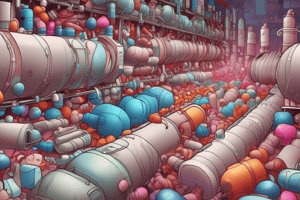Podcast
Questions and Answers
What is intrinsic resistance in bacteria?
What is intrinsic resistance in bacteria?
- Resistance developed through exposure to antibiotics
- Natural resistance due to the absence of a target (correct)
- Resistance due to enzymatic modification of antibiotics
- Resistance acquired through genetic mutations
Which mechanism contributes to the inactivation of antibiotics?
Which mechanism contributes to the inactivation of antibiotics?
- Efflux pumping of the antibiotic
- Alteration of the antibiotic target
- Modification of metabolic pathways
- Enzymatic breakdown of antibiotic molecules (correct)
What characterizes MRSA and VRSA as pathogens?
What characterizes MRSA and VRSA as pathogens?
- They can transfer resistance genes to other bacteria (correct)
- They lack resistance gene islands
- They only contain chromosomal resistance genes
- They are susceptible to all classes of antibiotics
Which bacteria is known to contribute 90% of all vancomycin-resistant infections?
Which bacteria is known to contribute 90% of all vancomycin-resistant infections?
What is a common characteristic of Clostridium difficile?
What is a common characteristic of Clostridium difficile?
What type of resistance occurs when a bacterium changes its genome to resist antibiotics?
What type of resistance occurs when a bacterium changes its genome to resist antibiotics?
Which type of bacteria lacks a cell wall and is resistant to β-lactam antibiotics?
Which type of bacteria lacks a cell wall and is resistant to β-lactam antibiotics?
How do bacteria often acquire antibiotic resistance?
How do bacteria often acquire antibiotic resistance?
What is the primary mode of action of macrolides?
What is the primary mode of action of macrolides?
Which antibiotic is classified under tetracyclines?
Which antibiotic is classified under tetracyclines?
Which of the following antibiotics is specifically known as a sulfonamide?
Which of the following antibiotics is specifically known as a sulfonamide?
What type of infections are lincomycins primarily used for?
What type of infections are lincomycins primarily used for?
Which antibiotic is recognized for renal toxicity but powerful effectiveness?
Which antibiotic is recognized for renal toxicity but powerful effectiveness?
Which of the following antibiotics is a polypeptide antibiotic?
Which of the following antibiotics is a polypeptide antibiotic?
Chloramphenicol is particularly effective against which infections?
Chloramphenicol is particularly effective against which infections?
What is a key characteristic of tetracyclines?
What is a key characteristic of tetracyclines?
What type of mycorrhizae penetrates the root cell wall?
What type of mycorrhizae penetrates the root cell wall?
Which fungal partners are primarily associated with ectomycorrhizae?
Which fungal partners are primarily associated with ectomycorrhizae?
What is the name of the thick-walled resting cell formed during sexual reproduction in Zygomycetes?
What is the name of the thick-walled resting cell formed during sexual reproduction in Zygomycetes?
Which of the following antiviral drugs is considered a prodrug?
Which of the following antiviral drugs is considered a prodrug?
What is a common mechanism by which antiviral drugs operate?
What is a common mechanism by which antiviral drugs operate?
What is a challenge of antiviral therapy?
What is a challenge of antiviral therapy?
In Ascomycetes, what is the asexual spore called?
In Ascomycetes, what is the asexual spore called?
What is the main action of Ganciclovir?
What is the main action of Ganciclovir?
Which antiviral drug incorporates into viral DNA and inhibits synthesis?
Which antiviral drug incorporates into viral DNA and inhibits synthesis?
Which type of virus does Acyclovir specifically target?
Which type of virus does Acyclovir specifically target?
Which of the following is NOT a method of asexual reproduction in fungi?
Which of the following is NOT a method of asexual reproduction in fungi?
What is a significant side effect of nonselective inhibitors of virus replication?
What is a significant side effect of nonselective inhibitors of virus replication?
Which type of fungi grows as both molds and yeasts?
Which type of fungi grows as both molds and yeasts?
What is the common name for spores produced by Zygomycetes in a swollen sac-like structure?
What is the common name for spores produced by Zygomycetes in a swollen sac-like structure?
What structure do ascospores develop within in Ascomycetes?
What structure do ascospores develop within in Ascomycetes?
Which of the following is NOT an indication for Acyclovir use?
Which of the following is NOT an indication for Acyclovir use?
What is the primary mechanism of action of beta-lactam antibiotics?
What is the primary mechanism of action of beta-lactam antibiotics?
Which of the following agents is a beta-lactam antibiotic?
Which of the following agents is a beta-lactam antibiotic?
Which method is typically used to differentiate viable and dead cells?
Which method is typically used to differentiate viable and dead cells?
What is the role of beta-lactamase inhibitors?
What is the role of beta-lactamase inhibitors?
Which of these antibiotics is known for having a very broad spectrum of activity?
Which of these antibiotics is known for having a very broad spectrum of activity?
What happens to bacteria when the cell wall synthesis is inhibited by beta-lactam antibiotics?
What happens to bacteria when the cell wall synthesis is inhibited by beta-lactam antibiotics?
Which generation of cephalosporins would you classify Ceftriaxone?
Which generation of cephalosporins would you classify Ceftriaxone?
What is NOT a type of beta-lactam antibiotic?
What is NOT a type of beta-lactam antibiotic?
Flashcards are hidden until you start studying
Study Notes
Macrolides
- Principally active against Gram-positive bacteria
- Show useful activity against penicillin-resistant strains
- Also effective against Gram-negative cocci
- Mode of action: Bacteriostatic, bind to the 50S ribosomal subunit to prevent the translocation step of bacterial protein synthesis
- Examples: Erythromycin, Azithromycin
Tetracyclines
- Broad spectrum antibiotic
- Characterized by their common octahydronaphthacene skeleton
- Examples: Tetracycline, Doxycycline, Minocycline
Lincomycins
- Known as Sulphur-containing Antibiotics
- Mode of action: Act via 50S ribosomal subunit binding and protein synthesis inhibition.
- Used in extra CNS anaerobic infections and in penicillin-sensitive patients
- Examples: Lincomycin, Clindamycin
Polypeptide Antibiotics
- Most powerful antibiotic agents but limited use due to renal toxicity.
- Used mainly locally in burns.
- Mode of action: Inhibit mucopeptide cell wall synthesis and interfere with semipermeability of the cell membrane
- Examples: Bacitracin, Gramicidin, Polymyxin
Unclassified Antibiotics
- Chloramphenicol: Used in meningitis, typhoid, and paratyphoid fever
Antibiotic Resistance
- Two types of resistance: intrinsic and acquired.
- Intrinsic resistance: Mycoplasma resistance to β-lactam antibiotics and other cell wall inhibitors due to the absence of a cell wall
- Acquired resistance occurs when a change in the bacterial genome converts a sensitive bacterium to a resistant one
Mechanisms for Acquiring Resistance
- Inactivation of the antibiotic through enzymatic breakdown (e.g., β-lactamase)
- Efflux pumping of the antibiotic out of the cell
- Modification of the antibiotic target
- Alteration of the bacterial pathway
Beta-Lactam Antibiotics
- Cell wall active agents
- Prevent the final step in the synthesis of the bacterial cell wall
- Range from very narrow spectrum to very broad spectrum
Mechanisms of Action for Beta-Lactam Antibiotics
- Beta-lactam antibiotics bind to Penicillin Binding Protein (PBP).
- Inhibition of PBP prevents the crosslinking of peptidoglycan chains.
- This prevents the bacteria from synthesizing a stable cell wall, leading to lysis (cidal effects).
Antiviral Drugs
- Antiviral agents block:
- Viral entry into or exit from the cell
- Viral replication inside the host cell
Mechanisms of Action for Antiviral Drugs
- Alter the cell’s genetic material (e.g. Acyclovir blocks viral enzymes and assembly of viral proteins)
- Prevent the newly formed virus from leaving the cell (e.g. Amantadine)
Challenges of Antiviral Therapy
- Rapid viral replication makes it difficult to develop effective antivirals.
- Rapid viral mutation can lead to drug resistance.
- Finding a drug that targets the virus without harming normal cells is difficult.
Antiviral Drug Properties
- They are virustatic, meaning they are active only against replicating viruses, and not latent viruses.
Herpes Simplex Virus (HSV) & Varicella-zoster Virus (VZV) Infections
- Herpes simplex viruses (HSV) cause repeated, blister-like lesions on the skin, genitals, and mucosal surfaces.
- HSV-type 1 is non-genital.
- HSV-type 2 causes genital infections.
Acyclovir
- Acyclovir is a guanosine analog that is primarily taken up by virus-infected cells.
- It selectively inhibits herpes virus DNA polymerase.
Clinical use of Acyclovir
- Treatment of Herpes simplex, Herpes zoster, Chickenpox and Epstain-Barr virus infections.
### Ganciclovir
- Ganciclovir is an analog of acyclovir effective against all Herpes viruses and CMV.
- Limited oral bioavailability, given intravenously.
Valacyclovir
- Valacyclovir is a prodrug of acyclovir.
- It has better bioavailability than acyclovir.
Studying That Suits You
Use AI to generate personalized quizzes and flashcards to suit your learning preferences.




